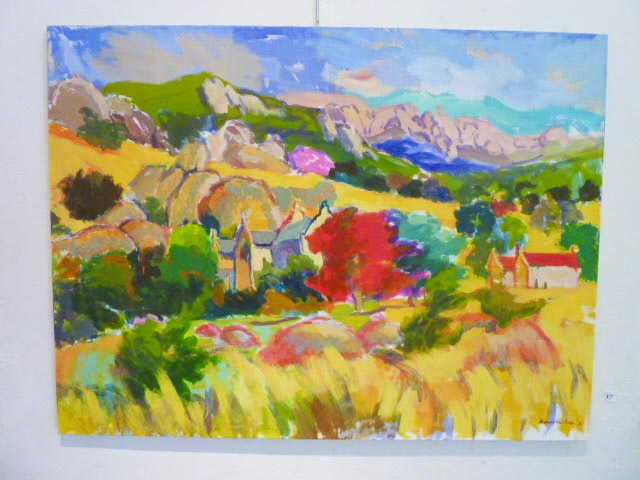


Landscape artists in Zimbabwe, wheth-er residing in town or in the rural areas, need never to journey very far for scenic inspiration.  Travelling a few minutes in any direction outside the city, an artist will find himself in virtually untouched natural surroundings, with perhaps only a stray goat or cow for company. There is also a ready market for landscape art, as any discerning tourist or visitor to Zimbabwe will want to take a memento home, and will be sure to visit a gallery to discover the best local art available. Local collectors, also, are constantly on the lookout for a beautiful painting to remind them of a holiday in the Eastern Highlands, a visit to Hwange National Park or a picnic on the rocks at Domboshava.
Travelling a few minutes in any direction outside the city, an artist will find himself in virtually untouched natural surroundings, with perhaps only a stray goat or cow for company. There is also a ready market for landscape art, as any discerning tourist or visitor to Zimbabwe will want to take a memento home, and will be sure to visit a gallery to discover the best local art available. Local collectors, also, are constantly on the lookout for a beautiful painting to remind them of a holiday in the Eastern Highlands, a visit to Hwange National Park or a picnic on the rocks at Domboshava.
A number of internationally famous artists spent their working lives in this country, travelling with their easels to remote beauty spots and creating paintings that hang on the walls of homes and institutions worldwide — a thing of beauty and a joy forever.
Joan Evans 1905-1986 who lived on a tobacco farm in Bindura in the 50s and then moved to Strathaven in Harare, painted rural scenes of trees, mountains and rivers in gentle colours of blue, pink and green. Labelled by some critics as being a ‘chocolate box’ artist, and greatly admired by others, her paintings are now worth thousands of dollars.
Jean Hahn, 1912-2006, lived in the Mazowe area, and spent long days seated at her easel in the bush. She painted mostly dry, wintry landscapes, characterised by yellowing grass, empty river beds and charred tree trunks.
Robert Paul, 1906-1980, is perhaps Zimbabwe’s best known local abstract landscape artist. His scenes, whether depicting the beach in neighbouring Beira in Mozambique, distant mountains in Juli-asdale, Nyanga, or Jacaranda trees in Livi-ngstone Avenue, Harare, never fail to thrill.
Currently exhibiting a one man exhibition at Gallery Delta in Livingstone Aven-ue, is Richard Witikani, another much-loved Zimbabwean artist. Born in 1967 in the shadow of the mystical Hwedza Mountains, his early playgrounds were mountain slopes and the off-limits caves near Imire Game Park, reputed to stretch for ten kilometres underground. Growing up in a rural environment, his inspiration comes from the far horizons, woodlands, granite outcrops and the swaying grasses that feature in many of his paintings. Although he is well-known as a landscape artist, his familiar portrayal of the human figure in different moods and poses always impresses, and at his current exhibition at Gallery Delta, The People and the Earth, both landscapes and figure studies proved popular with collectors and art lovers.
I first met Witikani in 1999 at Chikanga, near Mutare, when he participated in Batapata, an International Artists’ Workshop sponsored by the Triangle Network. Twenty two artists from Zimbabwe, Kenya, Uganda, Poland, UK, India, Pakistan and Papua New Guinea interacted with each other over a period several weeks. The works of art they created formed a travelling exhibition that opened at the Mutare National Gallery. Then, as now, Witikani worked as a free spirit, unfettered brush strokes and vivid use of colour opening up landscapes both familiar and mysterious, always alluring. The focal point of Chapman 2012 acrylic on canvas, is a gabled double storied building partly obscured by vermilion, turquoise and shadowy indigenous trees. Granite kopjes and dramatic clouds and sky form the backdrop, while tall yellowing grass sways in the foreground.
Witikani is as skilled at figure painting as with landscapes, and the two complement each other. ‘I paint the clothing of my figures bright’, he told me. ‘This also affects my landscapes.’ Early studies of the female form tended to be rounder and more curved — today Witikani’s models are slender, but still shapely, as in ‘Blue Dress’ 2013.
Although not far from town, the artist’s Hatfield studio is quietly peaceful and surrounded by grass and trees. In his semi-rural seclusion, Witikani is now responding to an abstract muse. Whatever this holds in store for the art world will be revealed at his next solo exhibition in 2014.